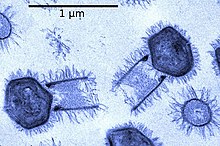| Tupanvirus | |
|---|---|

| |
| Virus classification | |
| (unranked): | Virus |
| Realm: | Varidnaviria |
| Kingdom: | Bamfordvirae |
| Phylum: | Nucleocytoviricota |
| Class: | Megaviricetes |
| Order: | Imitervirales |
| Family: | Mimiviridae (?) |
| Genus: | Tupanvirus |
| Species | |
Tupanvirus is a genus of viruses first described in 2018.[1] The genus is composed of two species of virus that are in the giant virus group.[2][3] Researchers discovered the first isolate in 2012 from deep water sediment samples taken at 3,000 m depth off the coast of Brazil.[1] The second isolate was collected from a soda lake in Southern Nhecolândia, Brazil in 2014.[1] They are named after Tupã (Tupan), a Guaraní thunder god, and the places they were found. These are the first viruses reported to possess genes for amino-acyl tRNA synthetases for all 20 standard amino acids.[1][4][5]
- ^ a b c d Abrahão J, Silva L, Silva LS, Khalil JY, Rodrigues R, Arantes T, et al. (February 2018). "Tailed giant Tupanvirus possesses the most complete translational apparatus of the known virosphere". Nature Communications. 9 (1): 749. Bibcode:2018NatCo...9..749A. doi:10.1038/s41467-018-03168-1. PMC 5829246. PMID 29487281.
- ^ "Tupanvirus altamarinense". ictv.global (taxon details). International Committee on Taxonomy of Viruses (ICTV). Retrieved 2024-07-27.
- ^ "Tupanvirus salinum". ictv.global (taxon details). International Committee on Taxonomy of Viruses (ICTV). Retrieved 2024-07-27.
- ^ Garisto, Dan (27 February 2018). "These giant viruses have more protein-making gear than any known virus". sciencenews.org. Science News. Retrieved 2021-04-07.
- ^ Schulz, Frederik; Yutin, Natalya; Ivanova, Natalia N.; Ortega, Davi R.; Lee, Tae Kwon; Vierheilig, Julia; Daims, Holger; Horn, Matthias; Wagner, Michael; Jensen, Grant J.; Kyrpides, Nikos C.; Koonin, Eugene V.; Woyke, Tanja (2017-04-07). "Giant viruses with an expanded complement of translation system components". Science. 356 (6333). eScholarship, University of California: 82–85. Bibcode:2017Sci...356...82S. doi:10.1126/science.aal4657. OCLC 9579903013. PMID 28386012.